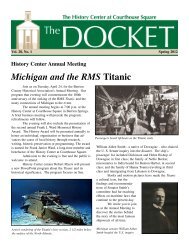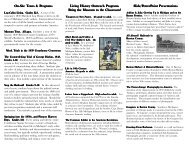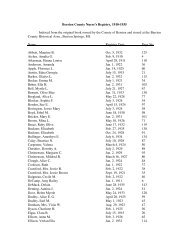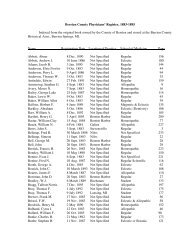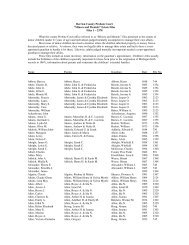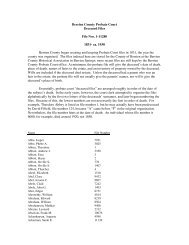Fall 2012 Docket.p65 - Berrien County Historical Association
Fall 2012 Docket.p65 - Berrien County Historical Association
Fall 2012 Docket.p65 - Berrien County Historical Association
You also want an ePaper? Increase the reach of your titles
YUMPU automatically turns print PDFs into web optimized ePapers that Google loves.
Page 7<br />
Curator’s Corner<br />
Recent Donations<br />
Clark Equipment Co. souvenirs . . Mary M. Addison-lamb<br />
Baby cradle, 1885 . . . . . . David, Debra & Richard Bartz<br />
Wedding dress, graduation dress. . . . . . . . Joellen Bellaire<br />
photographs, 1887 county atlas<br />
Map of St. Joseph, ca. 1860 . . . . . . . . Marcia M. Fleming<br />
Courthouse key, 1838 . . . . . . . .<br />
Fort St. Joseph Museum<br />
<strong>Berrien</strong> Springs photographs . . . . . . . . . . . . . Wayne Hall<br />
Telephone receiver, ca. 1940 . . . . . . . .<br />
Richard Kubsch<br />
World War I photographs, papers . . . . Patrick G. McIntosh<br />
St. Joseph brewery bottle, . . . . . Patrick & Maxine Walsh<br />
business directory, city planning book<br />
Patrick McIntosh donated this framed photograph of his father,<br />
Pvt. George McIntosh of St. Joseph. George, a Glenlord resident,<br />
served as a Michigan “Polar Bear” in Russia immediately after<br />
World War I (see below).<br />
Michigan Polar Bears<br />
Some of George McIntosh’s Polar Bear buddies stage a<br />
boxing match in Russia.<br />
McIntosh<br />
(arrow)<br />
poses with<br />
the Polar<br />
Bears on a<br />
log bridge in<br />
Russia.<br />
George F. McIntosh of Glenlord enlisted to fight<br />
the Kaiser, but wound up battling Bolsheviks. He joined<br />
the army in 1917 and served with the 310 th Engineers in<br />
the 85 th Division. The 85 th , composed mostly of Michigan<br />
and Wisconsin men, went to Arkhangelsk, Russia, in 1918<br />
to reinforce British troops already there. Officially the<br />
American North Russia Expeditionary Force, the outfit<br />
gained fame as “The Polar Bears.”<br />
The expedition had three objectives: prevent<br />
Allied war material stockpiles in Archangelsk from falling<br />
into German hands; rescue the Czech Legion, then<br />
stranded along the Trans-Siberian Railroad; and defeat the<br />
Red Army and reopen the Eastern Front against Germany.<br />
In the process, the Polar Bears would also halt the spread<br />
of communism.<br />
The expedition’s offensive ground to a halt in the<br />
Russian winter, and in 1919 the Polar Bears returned<br />
home. American forces lost over 110 men in battle,<br />
another 30 missing, and 70 deaths from disease, mostly<br />
due to the Spanish Flu. Pvt. George McIntosh returned<br />
home safely and was mustered out in July 1919.<br />
The History Center thanks George McIntosh’s son,<br />
Patrick, for his donation of rare photographs of the Polar<br />
Bear Expedition.




